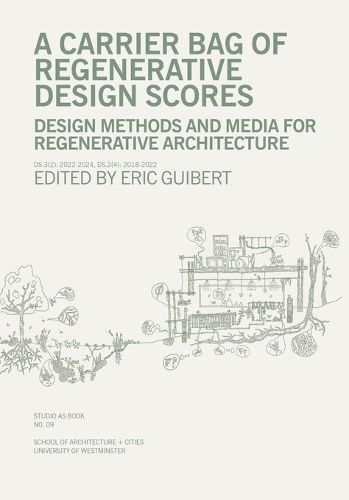Readings Newsletter
Become a Readings Member to make your shopping experience even easier.
Sign in or sign up for free!
You’re not far away from qualifying for FREE standard shipping within Australia
You’ve qualified for FREE standard shipping within Australia
The cart is loading…






This edition of studio-as-book reflects on the regenerative pedagogy and design methods used in B.A. Design Studios DS.3(2) & DS.2(4) tutored by Eric Guibert, Anthony Powis, Michael Spooner, Bruce Irwin, and Christopher Daniel between 2018 and 2024. The book is conceived as a CARRIER BAG holding the ten REGENERATIVE DESIGN SCORES developed in the studio and a collection of essays. We conceive "scores" as methods open for interpretation. Each score is explained and illustrated by key examples produced by students over the years.
The studio aimed to investigate what is now called regenerative architecture and the overlap between building and landscape architecture. We have been speculating on what such a design might be, how it may be created, and the transformative pedagogies that support such learning. This research has unfolded with regenerative approaches in architecture. We hope that this first synthesis of methods will help students, teachers, and practitioners alike.
$9.00 standard shipping within Australia
FREE standard shipping within Australia for orders over $100.00
Express & International shipping calculated at checkout
Stock availability can be subject to change without notice. We recommend calling the shop or contacting our online team to check availability of low stock items. Please see our Shopping Online page for more details.
This edition of studio-as-book reflects on the regenerative pedagogy and design methods used in B.A. Design Studios DS.3(2) & DS.2(4) tutored by Eric Guibert, Anthony Powis, Michael Spooner, Bruce Irwin, and Christopher Daniel between 2018 and 2024. The book is conceived as a CARRIER BAG holding the ten REGENERATIVE DESIGN SCORES developed in the studio and a collection of essays. We conceive "scores" as methods open for interpretation. Each score is explained and illustrated by key examples produced by students over the years.
The studio aimed to investigate what is now called regenerative architecture and the overlap between building and landscape architecture. We have been speculating on what such a design might be, how it may be created, and the transformative pedagogies that support such learning. This research has unfolded with regenerative approaches in architecture. We hope that this first synthesis of methods will help students, teachers, and practitioners alike.